Gagosian Quarterly Talks
Walton Ford and Irving Blum
Walton Ford sat down with legendary art dealer Irving Blum at Gagosian Beverly Hills to discuss his latest exhibition, Calafia.
Spring 2022 Issue
Walton Ford narrates the histories and myths behind two of his newest paintings.

Walton Ford, Stac an Armin, 2021, watercolor, gouache, and ink on paper, 89 ¼ × 60 ¼ inches (226.7 × 153 cm)
Walton Ford, Stac an Armin, 2021, watercolor, gouache, and ink on paper, 89 ¼ × 60 ¼ inches (226.7 × 153 cm)
Fifty miles from the coast of Scotland, the rocky islands of the St Kilda archipelago bristle out of the North Atlantic like a shattered spine. Stac an Armin is one of these shards of stone. Gannets, puffins, petrels, and fulmars nest on the ledges of this volcanic spike.
In the mid-nineteenth century, the island people of St Kilda survived by eating eggs, chicks, and full-grown birds from the island’s cliffs. Travel to and from the mainland was dangerous and rarely attempted. Most islanders had never seen a tree, a horse, a painting, a staircase, or a book besides the Bible. They saw only St Kilda and her birds, storms, orcas, sharks, seals, and native sheep. Their preachers also taught them to see either God’s wrath or the devil’s hand manifested in the grim weather, disease, melancholy, and lusts engulfing them.
Around the same time, the great auk of the north Atlantic was nearing extinction. This goose-sized bird was a cousin of the puffin. A flightless bird, the great auk resembled a penguin, having evolved to do the same job—namely, to “fly” under water and catch fish. All the great auks around St Kilda had been slaughtered for their down so many years before that the islanders had no memory of them.

Walton Ford, Stac an Armin, 2021 (detail), watercolor, gouache, and ink on paper, 89 ¼ × 60 ¼ inches (226.7 × 153 cm)
In July of 1840, five island men hunting birds on Stac an Armin found an auk asleep on a ledge. It was one of the last auks seen alive.
It was Malcolm McDonald who actually laid hold of the bird, and held it by the neck with his two hands, till others came up and tied its legs. It used to make a great noise, like that made by a gannet, but much louder, when shutting its mouth. It opened its mouth when any one came near it. It nearly cut the rope with its bill. A storm arose, and that, together with the size of the bird and the noise it made, caused them to think it was a witch. It was killed on the third day after it was caught, and McKinnon . . . was the most frightened of all the men, and advised the killing of it.1
I wanted to imagine what this auk/witch would be doing in the minds of those men. What would a witches’ sabbath look like in the mind’s eye of these islanders? What insular sexual tension was made sinister by shouts from the pulpit? The young Lauchlan McKinnon, “the most frightened of all the men,” saw an unknown animal. In that animal he saw a fearsome female creature, a woman assuming animal form, a lascivious witch in league with the devil and the animal world. He saw his frenzied fears made flesh to be killed and forgotten.
black-tailed, dusky, prairie, banded rock, and massasauga, all coiling and striking among cactus and sage.
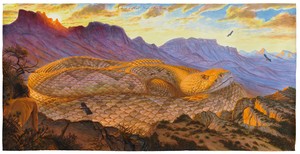
Walton Ford, Cabeza de Vaca, 2021, watercolor, gouache, and ink on paper, 60 × 119 ¾ inches (152.4 × 304.2 cm)
In 1528, Álvar Núñez Cabeza de Vaca got lost. He wandered, lost, for the next eight years, across what we now call the American Southwest. He was one of an expedition of over 300 Spaniards who waded behind Pánfilo de Narváez into the tangled swamps of Florida in search of golden cities. Bushwhacking away from their ships, they started to die. They built rafts and drowned. They starved and died of exposure. They were captured, killed, or enslaved by the native peoples. Cabeza de Vaca was one of only four survivors to finally stagger into Mexico.
Everywhere Cabeza de Vaca walked during his trek, he would have met rattlesnakes. There are no rattlesnakes in the old world. A Spaniard could not have dreamt of such a creature. In Florida, he would have been startled by pug-faced eastern diamondbacks, seven feet long; swift, mustard and rust-colored timber rattlers; and diminutive pygmy rattlesnakes buzzing like insects underfoot. Farther west, he would have confronted whiplash-angry western diamondbacks the color of dust. Black-tailed, dusky, prairie, banded rock, and massasauga, all coiling and striking among cactus and sage. All the way from Florida to Mexico, species after species—shape, pattern, and size shifting and changing.
I have painted Cabeza de Vaca’s delirium—a vision of fear and enormity.
Toward the end of his ordeal, Cabeza de Vaca began to see abandoned native villages, burned and looted. He knew he was nearing his Christian countrymen. By the time he finally met a mounted party of Spaniards he had become a revered healer among the native peoples, a mystic, bearded and browned. He was a shocking sight to his countrymen, who promptly enslaved his native companions. A few months later, Cabeza de Vaca was on a ship bound for Lisbon.
1J. A. Harvie-Brown and T. E. Buckley, A Vertebrate Fauna of the Outer Hebrides (Edinburgh: David Douglas, 1889), p. 159.
Artwork © Walton Ford
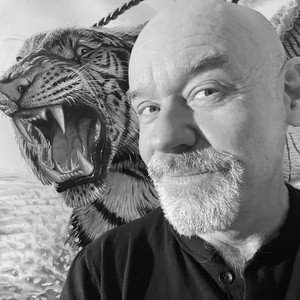
Walton Ford recasts, reverses, and rearranges the conventions of animal art. He is a devout researcher, responding to everything from Hollywood horror movies to Indian fables, medieval bestiaries, colonial hunting narratives, and zookeeper’s manuals. He grew up in the Hudson Valley, graduated from the Rhode Island School of Design, and currently lives and works in New York.
Walton Ford sat down with legendary art dealer Irving Blum at Gagosian Beverly Hills to discuss his latest exhibition, Calafia.
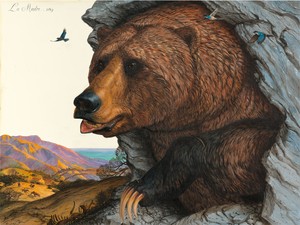
Walton Ford’s most recent paintings focus on the history of California through fantastical interpretations of humanity and its encounters with animal life.

David Cronenberg’s film The Shrouds made its debut at the 77th edition of the Cannes Film Festival in France. Film writer Miriam Bale reports on the motifs and questions that make up this latest addition to the auteur’s singular body of work.

Alice Godwin and Alison McDonald explore the history of Roy Lichtenstein’s mural of 1989, contextualizing the work among the artist’s other mural projects and reaching back to its inspiration: the Bauhaus Stairway painting of 1932 by the German artist Oskar Schlemmer.

The mind behind some of the most legendary pop stars of the 1980s and ’90s, including Grace Jones, Pet Shop Boys, Frankie Goes to Hollywood, Yes, and the Buggles, produced one of the music industry’s most unexpected and enjoyable recent memoirs: Trevor Horn: Adventures in Modern Recording. From ABC to ZTT. Young Kim reports on the elements that make the book, and Horn’s life, such a treasure to engage with.

Louise Gray on the life and work of Éliane Radigue, pioneering electronic musician, composer, and initiator of the monumental OCCAM series.
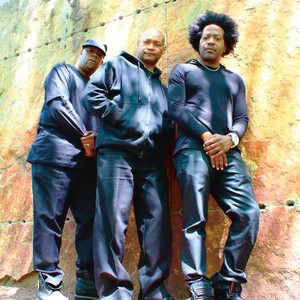
Tracing the history of white noise, from the 1970s to the present day, from the synthesized origins of Chicago house to the AI-powered software of the future.

Ariana Reines caught a plane to Barcelona earlier this year to see A Sea of Music 1492–1880, a concert conducted by the Spanish viola da gambist Jordi Savall. Here, she meditates on the power of this musical pilgrimage and the humanity of Savall’s work in the dissemination of early music.

Dan Fox travels into the crypts of his mind, tracking his experiences with goth music in an attempt to understand the genre’s enduring cultural influence and resonance.
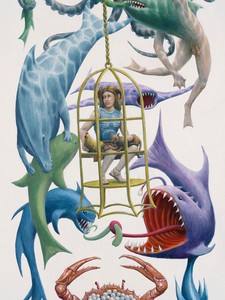
Charlie Fox takes a whirlwind trip through the Jim Shaw universe, traveling along the letters of the alphabet.
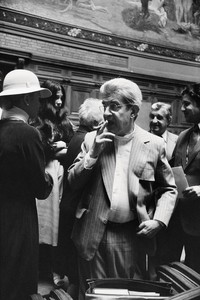
On the heels of finishing a new novel, Scaffolding, that revolves around a Lacanian analyst, Lauren Elkin traveled to Metz, France, to take in Lacan, the exhibition. When art meets psychoanalysis at the Centre Pompidou satellite in that city. Here she reckons with the scale and intellectual rigor of the exhibition, teasing out the connections between the art on view and the philosophy of Jacques Lacan.
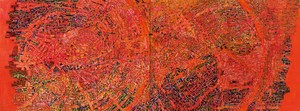
Dieter Roelstraete, curator at the Neubauer Collegium for Culture and Society at the University of Chicago and coeditor of a recent monograph on Rick Lowe, writes on Lowe’s journey from painting to community-based projects and back again in this essay from the publication. At the Museo di Palazzo Grimani, Venice, during the 60th Biennale di Venezia, Lowe will exhibit new paintings that develop his recent motifs to further explore the arch in architecture.